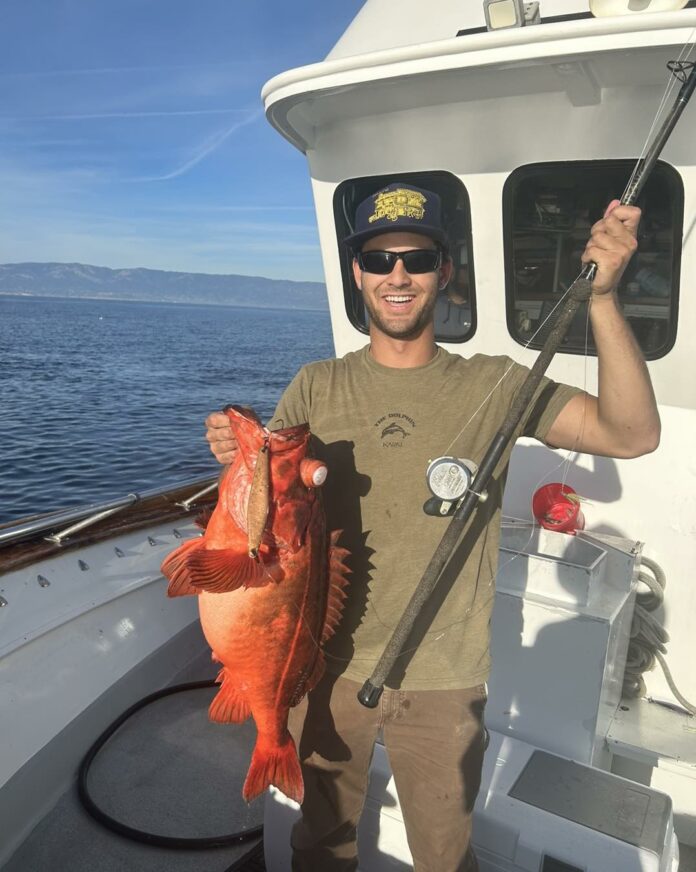BY MERIT McCREA
SAN DIEGO — The Department of Fish and Game Commission (DFGC) met in San Diego Wednesday and Thursday this past week. One of the items presented was the proposed 20-fathom point-to-point line the Department of Fish and Wildlife (Department) is working on.
Previously regulatory boundaries in state waters were mostly defined by either distance from shore or depth. However, enforcement has difficulty in proving such inexact demarcations and much prefers geographically described lines, now that GPS technology is available for more precise positioning – you are in or you are out, no discussion about radar reflections off coastlines or the state of the tide.
While enforcement is simply about instilling compliance to regulations by the public, when wardens write a ticket and commit to potentially spending a day or more in court, they want it to stick. They want the local District Attorney to stand behind the case and go to bat for them.
The exact point-to-point lines describing boundaries are important to them. Thus the Department has seen the need to establish those lines all along our coast and around islands. Offshore high-spots generally fall outside of state waters so there the state needs to go before the PFMC if they want those lines to regulate to.
At issue is providing better angler access to the nearshore RCG complex, about a dozen rockfish, lings, greenlings and cabezon. What’s happened is the state is tasked to prevent the fishing mortality of quillback rockfish.
Irrespective of whether you agree or not, the Best Available Scientific Information (BSIA) shows quillback rockfish in very low abundance in this state, so low that basically no catch can be allowed and even catch and release mortality alone projects to surpass the tiny, 1- to 2-metric ton Total Annual Catch that will be allowed in coming years.
In response the Department is gearing up to propose split seasons north of Point Lopez at 36N along the Monterey Big Sur Coast. While an earlier Council decision had initially used Pt. Conception as the southern extent of the species for management purposes, that has been updated, thankfully.
This was largely due to the efforts of both commercial fisherment and recreational anglers out of Morro Bay and Port San Louis, who brought to the PFMC’s attention the almost non-existent quillback catch for those two ports.
The idea has yet to be fleshed out to months and times but recreationally, it’s to offer fishing access beyond the PFMC 50-fathom lines part of the season and inside 20- for part.
Again, this would apply north of Pt. Lopez. Between there and Pt. Conception it appears anglers will only be constrained by their incidental catch of yellow-eye rockfish.
From there south, we still face the dilemma of keeping copper catches in line with low limits – not as restrictive as those for quillback but still likely to cost us time on the water again.
The 20-fathom map is available online and the public is invited to comment on that site. Here it is:
Draft Groundfish Management Boundaries web page
https://wildlife.ca.gov/Conservation/Marine/Groundfish/Boundaries.
Two things I noticed were:
The first is, where the 20-fa contour crosses out of state waters into federal (beyond the 3-mile line, SF area, Ventura Shelf, San Pedro-Long Beach Shelf) their proposal simply does a poor job of approximating the 3-mile line, one which is already in most plotter software. The fix here would be to end the point-to-point line at the cross and have state regulations apply to “state waters only.”
This would allow for an easy complementary action in federal waters under federal rules and the purview of the PFMC – without having to go back to the state and remove the bad lines along the 3-mile boundary as well.
The second is up at the Farallons. There the 20-fathom proposal does such a poor job of following the 20-fathom contour that there will be big enforcement problems.
The MPA takes up so much of the habitat that there will be considerable effort by anglers to maximize the remaining opportunity – and we already know that many folks follow the regulations by way of their depth finders mostly, rather than those lines.
The state should forego their effort to “economize on waypoints” and re-draw those lines there so that boaters fishing inside 20 fathoms are less likely to be outside the official lines.




